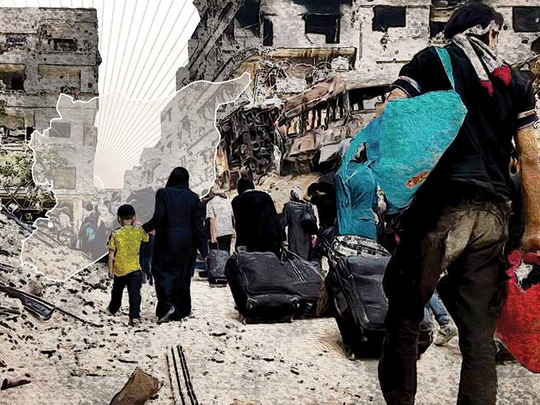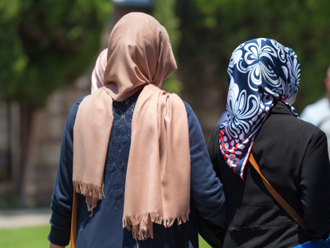
The evacuation of what’s left of the residents of the beleaguered Damascus suburb of Daraya on Saturday, after a four-year government siege and relentless bombing, is a stark reminder of one of the most crucial challenges in Syria’s bloody civil war: The fate of the displaced.
More than 3,000 civilians were transported to the rebel-held northern region of Idlib with no guarantee that they will ever return to their homes. The majority of Daraya’s residents are Sunnis.
Before that, similar deals were struck over Zabadani, where the entire population was forced to evacuate to Madaya, which is also under siege.
The same could happen to the residents of Wa’er district in Homs, where thousands of residents are facing starvation. The regime would have preferred to strangle the eastern neighbourhoods of Aleppo, where 300,000 residents are stuck, in an attempt to negotiate a truce that would lead to evacuation.
But the bigger picture is even gloomier. Of an estimated 12 million, at least 6.6 million Syrians are internally displaced within Syria, since March 2011, while more than five million have fled to neighbouring countries like Turkey, Lebanon and Jordan. Hundreds of thousands are believed to be dispersed in European countries. Those who were not able to leave the country have found temporary refuge in almost every Syrian governorate.
The most recent figures show that at least one million Syrians are internally displaced in the capital of Damascus and rural areas close to it. The Aleppo governorate is home to over 1.7 million displaced persons. Naturally it is difficult for international organisations to keep track of the movement of these people.
When government forces launched an organised attack against Aleppo towns under rebel control two months ago, it created an influx of more than a million people who headed north towards the Turkish borders. Few were able to cross.
Neighbouring countries have now closed their borders or are limiting the number of Syrians allowed to cross. Jordan, which has at least 1.3 million Syrians, closed its borders a few months ago, arguing that it could no longer accept additional refugees. Turkey has said that a safe camp should be set up on the Syrian side of its southern borders to accommodate additional refugees.
The closure of borders and the stemming of the flow of Syrians into Europe have added pressure on Syrians living in conflict zones within the country. The latest studies suggest that residents continue to be internally displaced and that many have been displaced multiple times. In many cases, these displaced persons have limited access to humanitarian assistance and are completely dependent on host communities.
Those living in besieged areas are in a much worse state. The UN reported in January that at least 400,000 Syrians are facing starvation in 15 areas across Syria. The UN is now negotiating a humanitarian truce to deliver aid to the eastern districts of Aleppo. But similar efforts in reaching Madaya, Fouaa and Kefraya in Idlib have been rarely successful.
The plight of millions of internally-displaced Syrians has drawn little international attention. International aid agencies admit that there are at least 4.2 million Syrians who are stranded in “hard to reach” areas as classified by the UN.
What is more worrying is that there are allegations that the regime is seeking to change the demographic realities in evacuated and abandoned areas now under its control along sectarian lines.
Last August, the Syrian opposition accused Tehran of attempting to change the demographics in areas close to Damascus with the goal of partitioning the country. A controversial population swap was concluded last year between the rebels and the regime, with UN, Turkish and Iranian mediation, under which Sunni residents of Zabadani would be taken to rebel-controlled areas in northern Syria, while the Shiite residents of Fua and Kefraya would be evacuated to territories under the control of the regime.
The extent and scope of similar population swaps is not known but experts warn that such deals will not only change the demographic composition of Syria forever and pave the way for a de facto partition of the war-torn country, but can be labelled war crimes and crimes against humanity.
Meanwhile, even if at some point hostilities were to stop and a political deal were reached, the fate of millions of Syrians who are internally displaced will still be in doubt.
Most of the towns and villages that witnessed confrontations are totally or partially destroyed. It would take decades and billions of dollars to rebuild them. The same fate awaits millions of Syrians who are housed in refugee camps in neighbouring countries. Repatriation will be the biggest post-war challenge for the international community and host countries.
The Syrian situation is not much different from what is happening in Iraq, where millions are internally displaced amidst accusations of systematic ethnic and sectarian cleansing taking place in mainly Sunni regions.
Regardless of what awaits these two countries, and countries hosting refugees, the demographic conditions that preceded the conflicts will never be restored.
Osama Al Sharif is a journalist and political commentator based in Amman.









